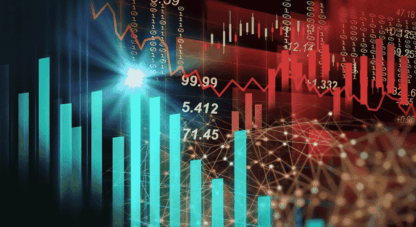If you’ve ever hit an ant pile with your lawnmower, you’re familiar with the ensuing reaction. Ants that were invisible a moment before appear by the thousands and start moving in every possible direction. The activity appears chaotic, but there is purpose. The ants try to protect the queen and their eggs, larvae, and pupae. They try to rebuild or move the colony. These things happen in time, but almost indiscernibly to the casual observer. So it is with the world economy.
The Covid pandemic was a huge mower that tore into the middle of the world economy. The stimulus checks sent out to help repair the damage turned out to be ant food-cum-poison—bringing inflation to an already stressed economy. To restrain the effects of that poisoned but greatly desired sugary food, the Fed has stepped on the ant pile several times to slow its activity. Strangely enough, the economy has not yet returned to normal.
So let’s summarize: An economy that had been fed the rich food of low- or no-interest money for 40 years has been severely interrupted. Attempts to rebuild have been too little, too late, and far too wrong to redress the damage—much less build a healthy economy of natural size, uniform opportunity, and robust strength.
If you want to build—or rebuild—an ant pile (no one does, but just roll with the metaphor), all you have to do is let it be. In French, you could say laissez faire. Adam Smith tried to teach us that phrase centuries ago, but Karl Marx, Benito Mussolini, John Maynard Keynes, and many others pronounce it differently. They say: “control my life.”
As officials around the world strive to make ants behave more like grasshoppers and are surprised that their colonies lose all form and function, the analysts below both explain what’s going on and give you ways to opt out of the destruction. A word to wise “ants” around the world: To survive, use the “food” that has sustained ants for thousands of years, not the sugary poison dispensed by central banks. Gold and silver are healthy. Fiat currency “tastes” good, but will harm you in the end.
Now that the ant metaphor has been mercilessly tortured to extract every possible comparison, see what the McAlvany analysts have to say this week, as summarized below.
Key Takeaways:
- The bear doesn’t stop chasing investors until they jettison all their stocks to get away from him
- “Old cycle” dynamics dominate emotions; “new cycle” dynamics dominate reality
- The Fed appears to pivot 360 degrees
- Buy in June before gold heads for the moon?
The McAlvany Weekly Commentary: As usual, David and Kevin cover a lot of ground in their weekly analysis. They note that the behavioral patterns of investors are revealed in the price movements of assets, and that investment advisor sentiment is the most bullish it has been since late 2021. This must be seen in the larger context of Alan Newman’s comment that bear markets are never over until you see capitulation. “Prices do not become truly attractive until participants are literally throwing stocks away—a sell-at-any-price mentality.” They also note the divergence in policy by central banks worldwide, as some continue to tighten monetary policy, while some—including the Fed—loosen or pause in their tightening process. They also focus attention on two developments they consider highly significant—the change in interest rates in the UK and the continued pressure in the Chinese economy.
Credit Bubble Bulletin: Doug covers some of the same ground as David, but from a different perspective. He compares “old cycle” dynamics with those of the “new cycle.” The former includes loose monetary conditions, high-flying equities, bubble dynamics around hot technologies, and an omnipotent Fed with its hand firmly on the tiller. New cycle dynamics include significant inflation that is now driving events worldwide, but especially in the UK, along with incidences of Soros’s “reflexivity” such as, “The Fed and global central bank community repeatedly employed progressively intrusive interventions, to the point where markets now virtually disregard the risk of a destabilizing de-risking/deleveraging episode.”
Hard Asset Insights: Morgan spends a good bit of time this week disabusing those who believe the highly anticipated Fed pivot is upon us of their unrealistic view. Not only does the economic situation clearly call for further tightening of the monetary supply, a strong consensus for doing so exists among the Fed governors—a consensus expressed by many of them in various forums. Chairman Powell himself told Congress, “It will be appropriate to raise rates again this year.” That’s pretty clear. “Unfortunately,” notes Morgan, “that higher-for-longer strategy greatly increases the odds of a severely hard-landing scenario for stocks and the economy.” What to do? “In the context of the current set-up, interested parties should…” well, this is a good point to refer you to the conclusion within the letter itself. Just click the link above.
Golden Rule Radio: Tory and Miles take a look at the down-trending gold chart and note that the action in gold is not only consistent with broader developments in markets, but commensurate with typical summer action in the metals markets. Miles make the important point that people who dollar-cost average into the markets often have excellent opportunities in the May to August timeframe each year. This is a longstanding tendency, so is not only no cause for concern, but very probably a cause for action. Tory notes that the long-term bullish trend for gold remains in place, so dips in the price of gold are simply opportunities to take advantage of that trend at lower entry levels and increase your profit opportunity. Silver could act similarly to gold this summer, and present similar opportunities.















